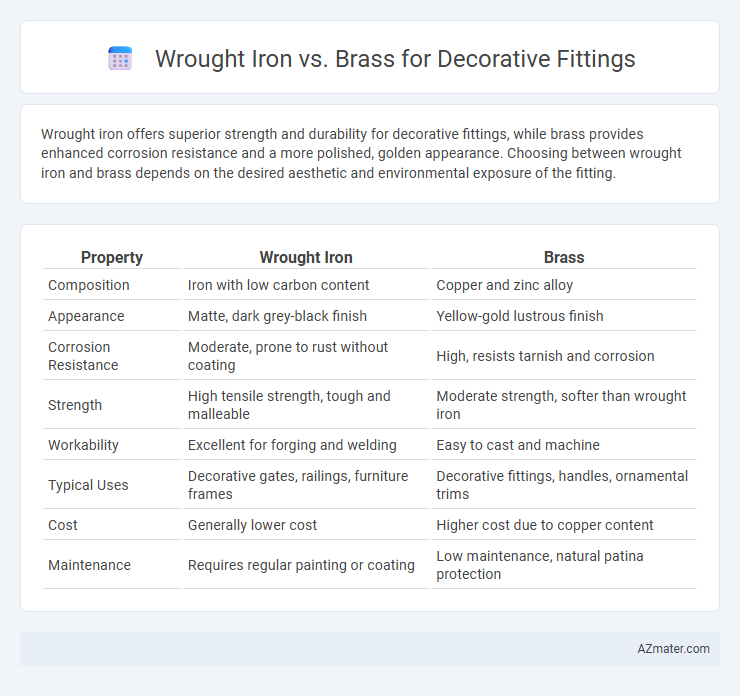Wrought iron offers superior strength and durability for decorative fittings, while brass provides enhanced corrosion resistance and a more polished, golden appearance. Choosing between wrought iron and brass depends on the desired aesthetic and environmental exposure of the fitting.
Table of Comparison
| Property | Wrought Iron | Brass |
|---|---|---|
| Composition | Iron with low carbon content | Copper and zinc alloy |
| Appearance | Matte, dark grey-black finish | Yellow-gold lustrous finish |
| Corrosion Resistance | Moderate, prone to rust without coating | High, resists tarnish and corrosion |
| Strength | High tensile strength, tough and malleable | Moderate strength, softer than wrought iron |
| Workability | Excellent for forging and welding | Easy to cast and machine |
| Typical Uses | Decorative gates, railings, furniture frames | Decorative fittings, handles, ornamental trims |
| Cost | Generally lower cost | Higher cost due to copper content |
| Maintenance | Requires regular painting or coating | Low maintenance, natural patina protection |
Introduction to Decorative Fittings
Decorative fittings crafted from wrought iron offer unparalleled durability and a timeless aesthetic, ideal for enhancing architectural elements with intricate designs and robust strength. Brass fittings, valued for their corrosion resistance and warm golden hue, provide a sophisticated look that complements both traditional and contemporary interiors. Choosing between wrought iron and brass depends on the desired balance of strength, decorative appeal, and environmental resilience for specific applications in decorative hardware.
Overview of Wrought Iron
Wrought iron, known for its exceptional durability and malleability, is a preferred material for decorative fittings due to its ability to be intricately handcrafted into detailed designs. Its high corrosion resistance and toughness make it ideal for both indoor and outdoor applications, ensuring longevity and minimal maintenance. Unlike brass, wrought iron offers a rustic, classic aesthetic that complements traditional and vintage decor styles.
Overview of Brass
Brass is an alloy of copper and zinc known for its bright gold-like appearance and excellent corrosion resistance, making it ideal for decorative fittings in both indoor and outdoor settings. Its malleability allows for intricate designs and smooth finishes, while its antimicrobial properties enhance hygiene in frequently touched fittings. Compared to wrought iron, brass requires less maintenance and offers a more polished, elegant aesthetic suitable for ornamental hardware.
Aesthetic Appeal: Wrought Iron vs Brass
Wrought iron offers a robust, rustic aesthetic with its dark, matte finish and intricate, hand-forged details, making it ideal for traditional or vintage decorative fittings. Brass provides a warm, golden luster that enhances elegance and sophistication, often preferred in classic and luxurious interior designs. The choice between wrought iron and brass depends on the desired visual impact and the complementary style of surrounding decor.
Durability and Longevity
Wrought iron offers superior durability due to its high tensile strength and resistance to wear, making it ideal for long-lasting decorative fittings exposed to outdoor conditions. Brass provides excellent corrosion resistance and maintains its aesthetic appeal over time, especially in indoor environments where moisture and weathering are minimal. Both materials can last decades with proper maintenance, but wrought iron generally outperforms brass in heavy-duty, high-impact applications.
Maintenance Requirements
Wrought iron requires regular maintenance such as cleaning and applying rust-resistant coatings to prevent corrosion, especially in humid environments. Brass, being a corrosion-resistant alloy, demands less frequent upkeep but benefits from periodic polishing to maintain its shine and prevent tarnish. Choosing between wrought iron and brass for decorative fittings depends on the desired aesthetic, environmental conditions, and acceptable maintenance efforts.
Versatility in Design
Wrought iron offers exceptional versatility in design with its ability to be molded into intricate shapes and detailed patterns, making it ideal for ornate decorative fittings. Brass provides a unique advantage with its warm golden color and excellent malleability, allowing for smooth curves and fine detailing that enhance aesthetic appeal. Both materials accommodate a broad range of styles, but wrought iron excels in robustness and rustic charm, while brass suits elegant, classical designs with its polished finish.
Cost Comparison
Wrought iron decorative fittings generally cost less than brass, making them a budget-friendly option for both residential and commercial projects. Brass fittings, known for their corrosion resistance and aesthetic appeal, tend to have a higher price due to the metal's natural properties and manufacturing complexity. The cost difference varies depending on size, design intricacy, and finish, with wrought iron offering durability at a lower upfront investment compared to the premium pricing of brass.
Best Uses for Wrought Iron and Brass in Decor
Wrought iron is prized for its strength and durability, making it ideal for outdoor decorative fittings such as gates, railings, and garden furniture that require resistance to weather and wear. Brass offers excellent corrosion resistance and a warm golden appearance, perfect for indoor decorative fittings like door handles, light fixtures, and cabinet hardware where aesthetic appeal and intricate detailing are important. Choosing wrought iron suits robust, structural designs, while brass excels in ornamental accents that enhance interior decor.
Which is Better for Decorative Fittings?
Wrought iron offers superior strength, durability, and classic rustic appeal, making it ideal for heavy-duty decorative fittings that require long-lasting support. Brass provides a more refined, polished look with excellent corrosion resistance and low maintenance, perfect for decorative fittings where aesthetic elegance and intricate detailing are prioritized. The choice between wrought iron and brass depends on whether strength and durability or decorative sophistication and ease of upkeep are the primary requirements for the fittings.

Infographic: Wrought iron vs Brass for Decorative fitting
 azmater.com
azmater.com